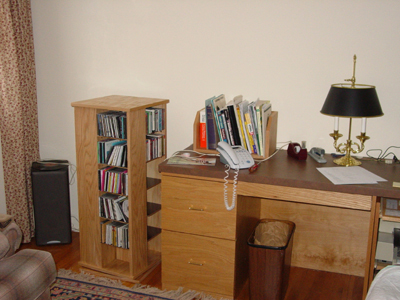 Office furniture is made of oak and oak-faced plywood. Drawers are birch-faced plywood.
Office furniture is made of oak and oak-faced plywood. Drawers are birch-faced plywood.
|
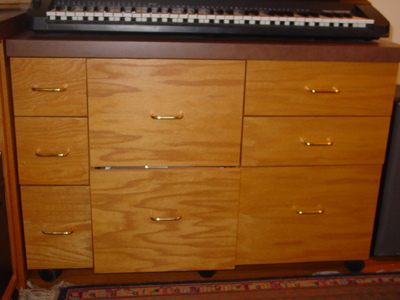 The keyboard cabinet holds my MIDI keyboard, which connects to the PC for my music arranging hobby.
The keyboard cabinet holds my MIDI keyboard, which connects to the PC for my music arranging hobby.
|
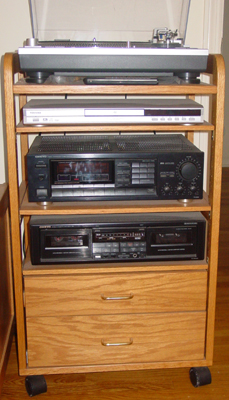 This is the first piece I every made. It holds my obsolete but still working stereo equipment.
This is the first piece I every made. It holds my obsolete but still working stereo equipment.
|
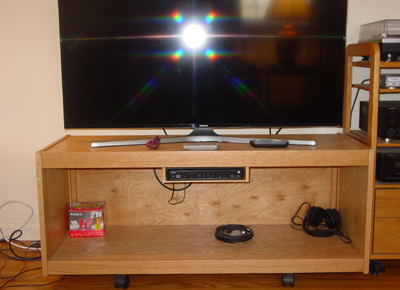 The TV outgrew a previous stand, so I made this one.
The TV outgrew a previous stand, so I made this one.
|
 I'm showing my age. I still have a collection of classical and jazz LPs.
I'm showing my age. I still have a collection of classical and jazz LPs.
|
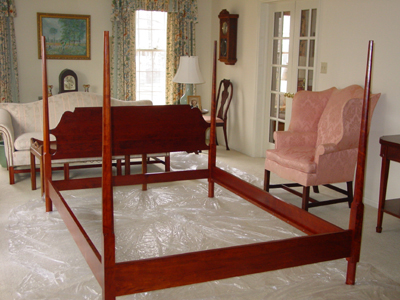 This bed has tapered octagonal posts, has mortise and tenon joints, is dye-stained and urethane finished.
This bed has tapered octagonal posts, has mortise and tenon joints, is dye-stained and urethane finished.
|
 This is a better view of the headboard.
This is a better view of the headboard.
|
 Cherry Bed Finial.
Cherry Bed Finial.
|
 I have made three of these bedside tables and they are used in several places in the house. One of them is beside a bed.
I have made three of these bedside tables and they are used in several places in the house. One of them is beside a bed.
|
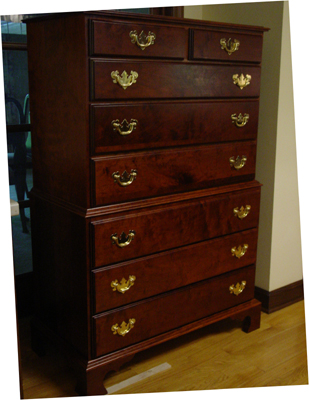 Mortise and tenon joinery, two-chest construction. Primary wood is cherry, and drawers are made of poplar. Urethane finish.
Mortise and tenon joinery, two-chest construction. Primary wood is cherry, and drawers are made of poplar. Urethane finish.
|
 Drawer separators are made of poplar and birch-faced plywood.
Drawer separators are made of poplar and birch-faced plywood.
|
 Drawers have half-blind dovetail joinery.
Drawers have half-blind dovetail joinery.
|
 A studio easel with rotating frame and a rod for stabilizing the hand, made for sitting down while painting.
A studio easel with rotating frame and a rod for stabilizing the hand, made for sitting down while painting.
|
 The coffee table is my only experience with walnut. It has mortise and tenon joints, dyes, and urethane finish.
The coffee table is my only experience with walnut. It has mortise and tenon joints, dyes, and urethane finish.
|
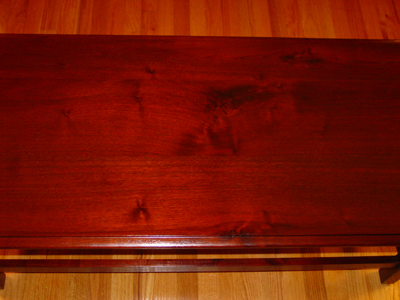 Dyes bring out the color and grain of the wood, as this view shows.
Dyes bring out the color and grain of the wood, as this view shows.
|
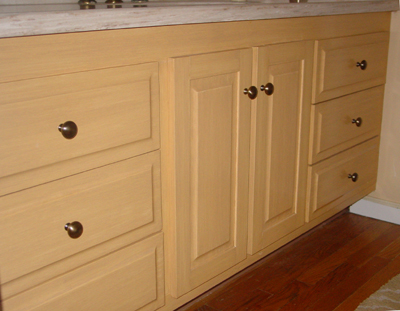 Made of maple, biscuit joinery, finished by my wife Dorothy.
Made of maple, biscuit joinery, finished by my wife Dorothy.
|
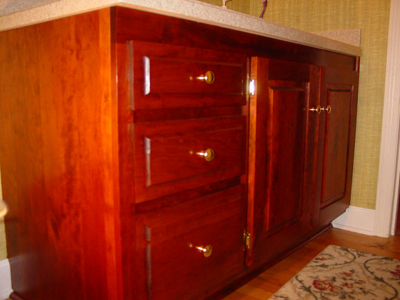 I made this cabinet for our powder room. It is stained with dyes and finished with polyurethane.
I made this cabinet for our powder room. It is stained with dyes and finished with polyurethane.
|
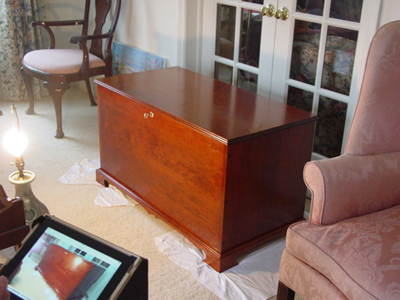 This piece sits in our living room.
This piece sits in our living room.
|
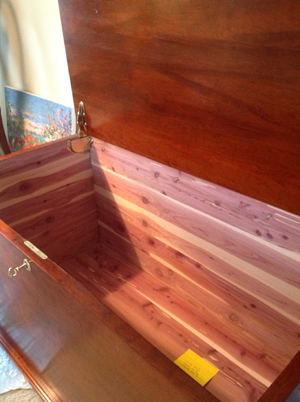 This shows the cedar lining of the chest.
This shows the cedar lining of the chest.
|
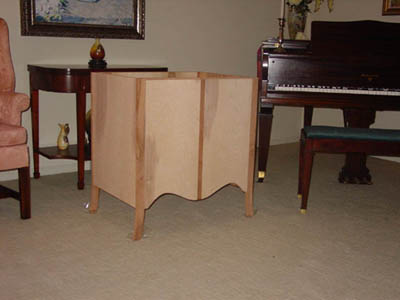 I made this cabinet 'to order' from a magazine picture my sister Harriett found.
I made this cabinet 'to order' from a magazine picture my sister Harriett found.
|
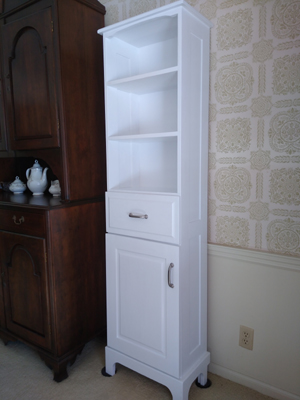 This cabinet was made to fit a narrow bathroom for my sister Myra. It is made of maple, with birch plywood inset on the sides, and has biscuit joinery. There are two adjustable shelves behind the door.
This cabinet was made to fit a narrow bathroom for my sister Myra. It is made of maple, with birch plywood inset on the sides, and has biscuit joinery. There are two adjustable shelves behind the door.
|
< /tr>
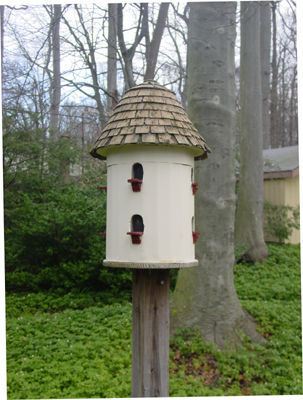 The birdhouse is almost 20 years old. Since I didn't have a table saw at the time, I cut the barrel stave angles on my radial arm saw. The cedar shakes for the roof were individually hand cut, and are held in place with silicone caulk.
The birdhouse is almost 20 years old. Since I didn't have a table saw at the time, I cut the barrel stave angles on my radial arm saw. The cedar shakes for the roof were individually hand cut, and are held in place with silicone caulk.
|
 The swing is at least ten years old. It is made of treated lumber, finished with an opaque stain. We take it in every winter to make it last longer.
The swing is at least ten years old. It is made of treated lumber, finished with an opaque stain. We take it in every winter to make it last longer.
|
My workshop has most of the power equipment a woodworker needs, except for a lathe (which I don't really want) and a few specialties such as a shaper and an overhead router.
I can do my own millling, which allows me to start with rough lumber and make my own boards.
A lot of my equipment was obtained from my friend Alan Bates when (at age 85) he decided to quit woodworking...he gave me a really good deal on it.
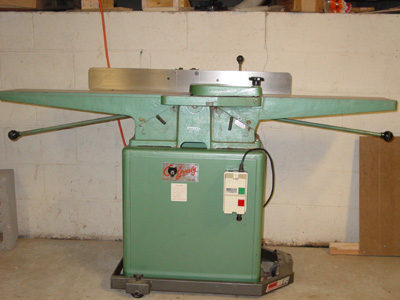
The Grizzly jointer is the heaviest tool in the shop. It can process wood up to 8 inches wide, and can create a smooth flat side and a smooth straight edge for joining. It has a 220V motor and three blades in the cutter.
Set up of the jointer is one of the most difficult tasks of the shop; it must be precisely set up to work properly. It has a roller stand for easy movement when needed.
|
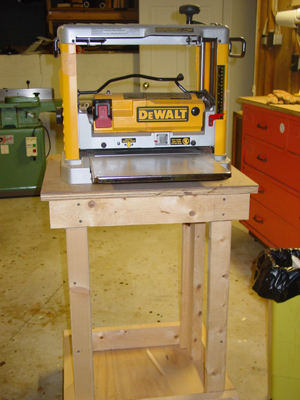
The DeWalt planer is the companion to the jointer. It takes boards on which one side has been made flat by the jointer, and makes the other side parallel to it and smooth.
Mine is 12 inches wide, has a 3-blade cutter, and operates on 110V current. The planer automatically adjusts the processing rate based on the amperage required. I keep mine on a home-made stand with rollers so it stays out of the way when not in use.
|
 The Delta 10-inch table saw is the workhorse of my shop. It can make rip cuts accurately up to 30 inches wide. I made a 6 foot long table to receive boards as they pass through the saw; it also serves as a worktable.
Cross cuts are made by using a "sled" which fits into one of the slots of the table. It can make dados and rabbets with my Freud 7-inch dado blade set.
|
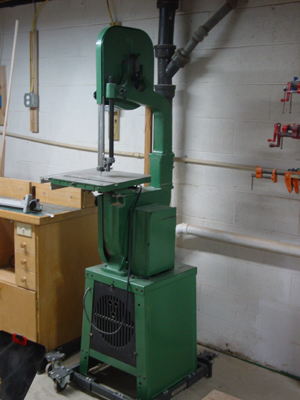
My Grizzly band saw has a 14 inch throat, and operates on 220V. It has an extension for resawing (a feature which I have never used) and a removable fence. It has its own roller stand.
The band saw is mainly useful for making curved cuts.
|
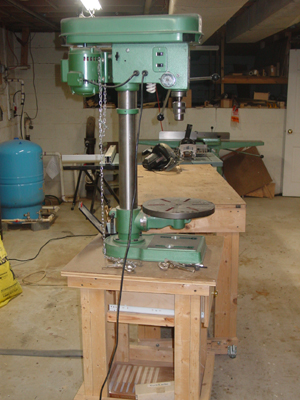
My Grizzly 5-speed drill press, mounted on a home-made stand.
It is often useful for accurately making true vertical holes which are difficult with a hand-held drill.
|
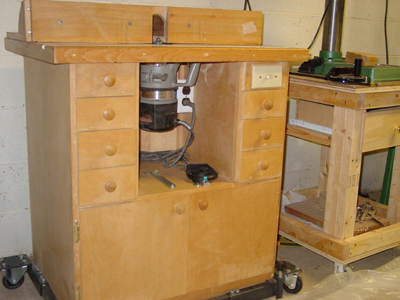
My router table was built by Alan Bates using a pattern from American Woodworker magazine. I have a Porter-Cable router mounted in it.
I use it for making moldings, tabletop edges, etc.
|

This is an excellent tool for cutting off boards and for cutting angles. It has poor dust control, though.
|
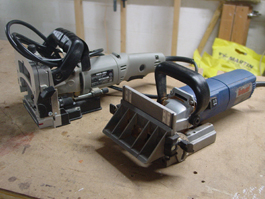
I'm getting away from biscuits, but still use them occasionally. I prefer the Porter-Cable. I got the Freud with the tools from Al Bates.
|

The scroll saw can cut accurate curved outlines in thin wood pieces.
|
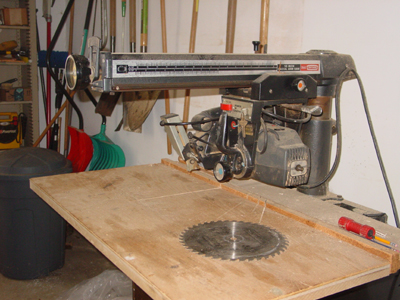
I have owned this relic for over 45 years, It has mostly been supplanted by the miter saw but still has occasional use, especially for outdoor carpentry projects. I keep it in the garage.
|
 Office furniture is made of oak and oak-faced plywood. Drawers are birch-faced plywood.
Office furniture is made of oak and oak-faced plywood. Drawers are birch-faced plywood. The keyboard cabinet holds my MIDI keyboard, which connects to the PC for my music arranging hobby.
The keyboard cabinet holds my MIDI keyboard, which connects to the PC for my music arranging hobby. This is the first piece I every made. It holds my obsolete but still working stereo equipment.
This is the first piece I every made. It holds my obsolete but still working stereo equipment. The TV outgrew a previous stand, so I made this one.
The TV outgrew a previous stand, so I made this one. I'm showing my age. I still have a collection of classical and jazz LPs.
I'm showing my age. I still have a collection of classical and jazz LPs. This bed has tapered octagonal posts, has mortise and tenon joints, is dye-stained and urethane finished.
This bed has tapered octagonal posts, has mortise and tenon joints, is dye-stained and urethane finished. This is a better view of the headboard.
This is a better view of the headboard.  Cherry Bed Finial.
Cherry Bed Finial.  I have made three of these bedside tables and they are used in several places in the house. One of them is beside a bed.
I have made three of these bedside tables and they are used in several places in the house. One of them is beside a bed.  Mortise and tenon joinery, two-chest construction. Primary wood is cherry, and drawers are made of poplar. Urethane finish.
Mortise and tenon joinery, two-chest construction. Primary wood is cherry, and drawers are made of poplar. Urethane finish.  Drawer separators are made of poplar and birch-faced plywood.
Drawer separators are made of poplar and birch-faced plywood.  Drawers have half-blind dovetail joinery.
Drawers have half-blind dovetail joinery.  A studio easel with rotating frame and a rod for stabilizing the hand, made for sitting down while painting.
A studio easel with rotating frame and a rod for stabilizing the hand, made for sitting down while painting.  The coffee table is my only experience with walnut. It has mortise and tenon joints, dyes, and urethane finish.
The coffee table is my only experience with walnut. It has mortise and tenon joints, dyes, and urethane finish. Dyes bring out the color and grain of the wood, as this view shows.
Dyes bring out the color and grain of the wood, as this view shows.  Made of maple, biscuit joinery, finished by my wife Dorothy.
Made of maple, biscuit joinery, finished by my wife Dorothy.  I made this cabinet for our powder room. It is stained with dyes and finished with polyurethane.
I made this cabinet for our powder room. It is stained with dyes and finished with polyurethane.  This piece sits in our living room.
This piece sits in our living room. This shows the cedar lining of the chest.
This shows the cedar lining of the chest. I made this cabinet 'to order' from a magazine picture my sister Harriett found.
I made this cabinet 'to order' from a magazine picture my sister Harriett found.  This cabinet was made to fit a narrow bathroom for my sister Myra. It is made of maple, with birch plywood inset on the sides, and has biscuit joinery. There are two adjustable shelves behind the door.
This cabinet was made to fit a narrow bathroom for my sister Myra. It is made of maple, with birch plywood inset on the sides, and has biscuit joinery. There are two adjustable shelves behind the door.  The birdhouse is almost 20 years old. Since I didn't have a table saw at the time, I cut the barrel stave angles on my radial arm saw. The cedar shakes for the roof were individually hand cut, and are held in place with silicone caulk.
The birdhouse is almost 20 years old. Since I didn't have a table saw at the time, I cut the barrel stave angles on my radial arm saw. The cedar shakes for the roof were individually hand cut, and are held in place with silicone caulk.  The swing is at least ten years old. It is made of treated lumber, finished with an opaque stain. We take it in every winter to make it last longer.
The swing is at least ten years old. It is made of treated lumber, finished with an opaque stain. We take it in every winter to make it last longer.  My workbench is an old lab bench which I bought cheap at a Dupont Company salvage sale. It isn't pretty, but it serves me well.
My workbench is an old lab bench which I bought cheap at a Dupont Company salvage sale. It isn't pretty, but it serves me well.











